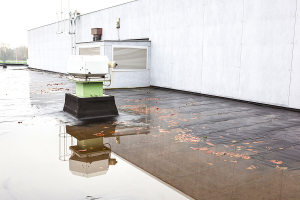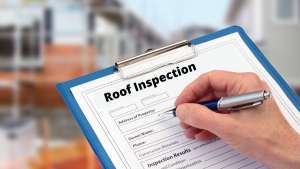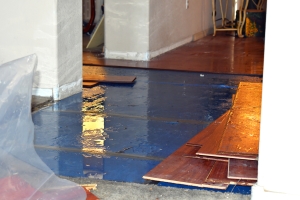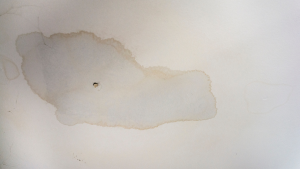Water. It’s essential to life, but when it leaks through your roof and into your property, it can cause damage that leads to costly repairs. Luckily, most roof leaks can be prevented. To best prevent water damage from a leaking roof, it’s important to know the kinds of damage water can cause, understand how this damage occurs, and put practices in place to prevent it. With the right prevention plan, you can significantly reduce the cost of water damage to your property.
Types of Water Damage

- Rotted or rusted roof decking
- Rotted roof framing
- Saturated insulation
- Drywall damage
- Flooring damage
- Electrical damage
And the longer you wait to fix water damage or its causes, the worse the damage will become. Any amount of moisture that’s left untreated will only cause the damage to escalate. If water has leaked into your property, clean it up quickly and call a roofing professional right away.
How Does Water Damage Occur?
It’s important to have a professional assess your water damage to determine the extent of repairs needed and to root out any underlying conditions. Some common causes of water damage are:
- Missing shingles or other damage due to high winds or storms.
- Damaged flashing around chimneys, vents, pipes, and skylights.
- Inadequate runoff, especially when paired with a low-slope roof.
- Ice dams caused by snow and ice buildup in the winter months.
- Improper roofing installation or inadequate repairs.
- Leaks from HVAC systems or broken pipes.
Because many of these factors may not be noticeable in the day-to-day, it’s important to schedule regular roofing inspections. Even small leaks can cause significant damage if they are not taken care of right away. Therefore, sticking with a routine inspection schedule is a key part of preventing expensive repairs.
The Cost of Water Damage to Your Roof
If the damage is allowed to become severe, water damage restoration will involve much more than minor roof repairs. From drywall and insulation to the structural elements of your roof, you could be left spending thousands of dollars on water damage repair. Some of the most commonly needed repairs due to water damage are:
Roofing repairs
Water can damage the various materials that make up your roof, including shingles, flashing, decking, and more. Diagnosing and repairing your roof is best left to the pros, as improper repairs or installation can lead to more severe issues.
Insulation replacement
When insulation becomes soaked from leaking water, not only does it become less efficient, it can cause a host of other problems down the road. Wet insulation can eventually cause mold growth, corrosion of roofing fasteners, rusting of steel studs and wall ties, and even structural warping.
Ceiling repairs
Ceiling water damage will mean repairing or replacing the tiles, drywall, or other material that makes up your ceiling. Even if the damage doesn’t look severe, water that has seeped through your roof and insulation to reach your ceiling can cause mold or mildew buildup if not taken care of. Simply painting over the water stains won’t fix the problem.
Drywall repair or replacement
Water damage that extends to your walls will require repair or replacement of the drywall. Like in your ceiling, wet drywall can be a breeding ground for mold and mildew. Smaller areas of damage might be repairable, but larger areas will need to be fully replaced.
 Flooring repair or replacement
Flooring repair or replacement
Some types of flooring will be more susceptible to water damage than others. Carpet and laminates, for instance, will quickly soak up water and degrade the subfloor. Hardwood floors, on the other hand, can withstand being covered in water for short periods of time before serious damage sets in. And tile, of course, is designed to be water-resistant. However, the grout could be damaged, leading to further issues if not repaired in a timely manner.
Electrical repairs
Water that reaches the electrical elements of your building can cause damage to your wiring and lights. Electrical water damage has the potential to be very dangerous, so repairs should be handled by an electrician as quickly as possible.
Mold removal and restoration
Whenever moisture is trapped, mold and mildew are never far behind. Mold mitigation can be costly, and the longer the moisture sits, the greater the risk and cost of removal.
The costs of these repairs will vary widely depending on the extent of the damage, type of material being replaced, and more. But the fact of the matter is, preventing water damage and taking care of roof repairs and leaks when they are small will save you big in the long run.
Prevent Water Damage With These 7 Tips
Preventive maintenance is a crucial part of mitigating the extent of water damage and keeping repair costs down. As with so many areas of life, an ounce of prevention is worth a pound of cure here. The following tips will help you prevent water damage:
 Use high quality contractors to install or repair your roof
Use high quality contractors to install or repair your roof
In the long run, improper installation and repairs can cause more problems than they fix. Always hire a quality contractor for your roofing needs
Fix areas of ponding right away
If you notice water pooling (or “ponding”) on your roof after it rains, it’s time to have some repairs done. Ponding can cause rot, eventually leading to leaks. Flat and low-sloped roofs are more prone to this issue, but ponding can happen on any roof.
Clean gutters regularly
The purpose of your gutters is to direct water runoff away from your roof and siding. Clogged gutters can cause water to pool on your roof, increasing your chance of leaks. Keep an eye out for leaky, rusted, or twisted gutters as well, and have them repaired right away.
Watch for damaged flashing
Flashing is the flexible metal that protects the joints around the openings in your roof (chimneys, vents, and skylights, for instance). If the flashing is bent, rusted, or loses its seal, it can’t do its job of preventing leaks. Routine roof inspections can catch damaged flashing, allowing you to fix it before water damage occurs.
 Keep an eye on your attic ceiling
Keep an eye on your attic ceiling
Watch for damaged or moldy insulation and rotting or stained ceiling boards or panels, as well as puckered or discolored sheetrock. All of these can be signs of roof leaks. If you notice any of these issues, call a roofer right away.
Remove snow and ice buildup after heavy winter storms
Keeping your roof clear of snow and ice can help prevent ice dams, which can cause melting snow to pool and eventually lead to leaks and water damage. You can use a roof rake to remove snow and ice, or call a professional to deal with it for you.
Inspections, inspections, inspections

 Flooring repair or replacement
Flooring repair or replacement Use high quality contractors to install or repair your roof
Use high quality contractors to install or repair your roof Keep an eye on your attic ceiling
Keep an eye on your attic ceiling